How Pallet Inverters Solve Pallet Standard Switching between US and EU Specs in Canada?
As an engineer who has spent his entire career in the packaging industry, I've seen a lot of logistical challenges. One of the most persistent, especially for my clients in Canada, is the headache of pallet standards. Your goods might be heading south to the US on a standard 48x40 inch pallet, but the next shipment needs to go to Europe on a 1200x800mm Euro pallet. For years, the only solution was manual labor: a team of workers physically unstacking and restacking an entire load. This process is slow, dangerous, and a constant source of product damage and delays. It’s a bottleneck that quietly drains profits and creates unnecessary risk right on the loading dock. But what if you could switch an entire pallet load in under a minute, with one person, and without anyone ever touching the product? This isn't a future dream; it's a reality made possible by a powerful piece of equipment.
A pallet inverter is the definitive solution for switching loads between US and EU pallet standards in a Canadian logistics environment. This machine works by securely clamping a fully loaded pallet, rotating it 180 degrees, and then lowering it so the original pallet can be easily removed from the top. A new pallet, matching the destination's specifications, is then placed on the load before it's rotated back. This entire mechanical process eliminates manual handling, dramatically increases speed, prevents product damage, and ensures a safe, efficient transfer every time.
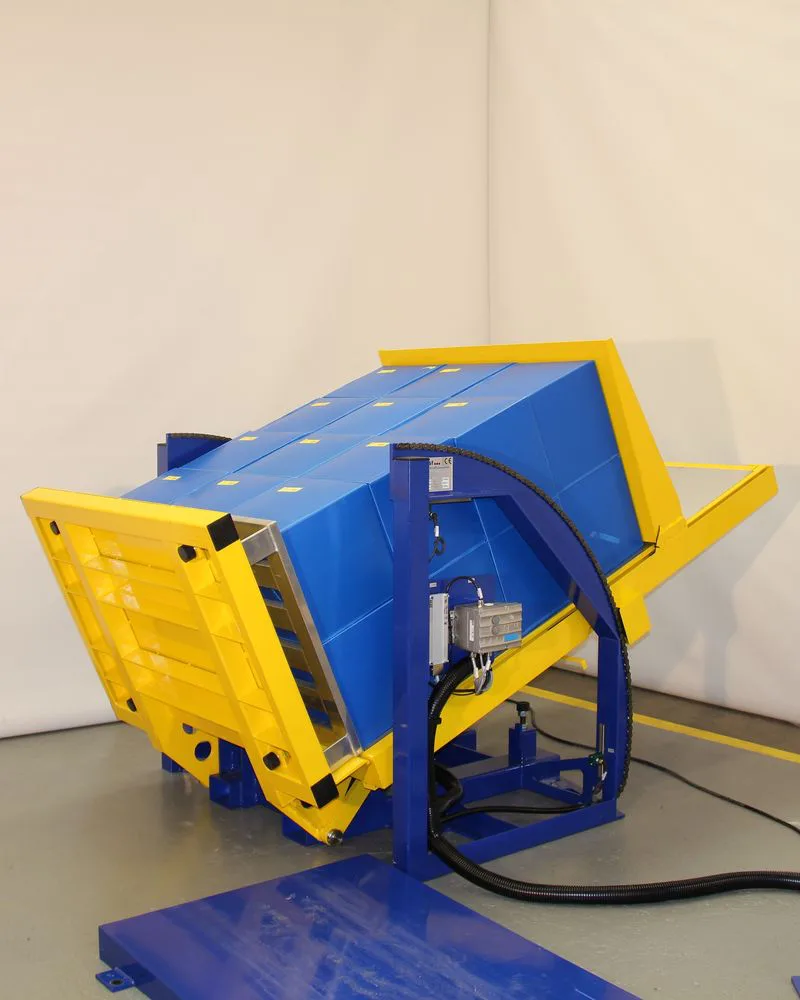
The concept is simple, but its impact on an operation is profound. I’ve seen it firsthand transform warehouse floors from chaotic and risky environments into models of efficiency. For any Canadian business involved in international trade, understanding how this technology works isn't just an operational detail—it's a strategic advantage. Let’s dive deeper into the specific problems it solves and how it can directly benefit your bottom line.
You see the hourly wages of the workers assigned to restack pallets, and you probably factor that into your cost of goods. But that's just the tip of the iceberg. The real financial damage is happening below the surface, in areas that don't always show up on a spreadsheet until it's too late. When a pallet topples, or a shipment is rejected because of unstable stacking, the costs multiply. These hidden expenses, from damaged products to workplace accidents, represent a significant and uncontrolled drain on your resources.
The most significant hidden costs of manually switching pallets include expensive product damage from drops and improper handling, the high price of workplace injuries and subsequent insurance claims, major time wastage leading to shipping delays and costly truck detention fees, and a general decrease in operational throughput and efficiency. These factors combined often cost a business far more than the direct labor involved.
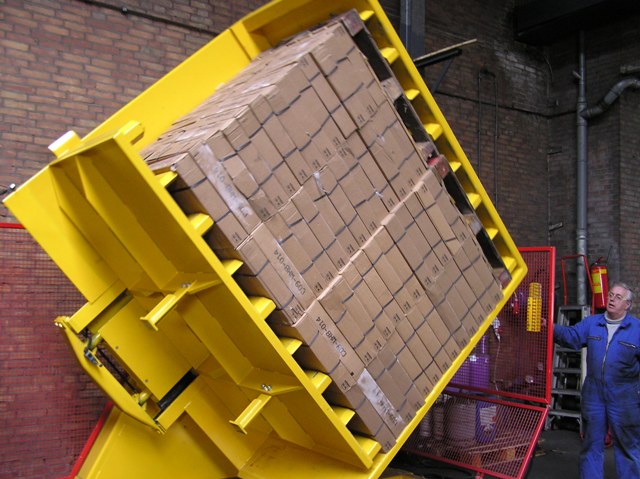
The True Cost of Damaged Goods
When your team is manually moving boxes, bags, or pails from one pallet to another, the risk of something getting dropped, crushed, or punctured is incredibly high. Let's break down the real cost. First, there's the cost of the product itself—a direct loss. Second, you have the labor cost that was spent producing and handling that now-unsellable item. Third, there are disposal costs. You can't just throw everything in the trash; some materials require special disposal methods, adding another expense. Finally, and perhaps most importantly, there's the cost to your reputation. A customer receiving a damaged shipment is an unhappy customer. It can lead to contract penalties, lost trust, and a damaged brand image that is very difficult to repair. A pallet inverter handles the entire load as a single, stable unit. The product is never touched, so the risk of this kind of damage drops to virtually zero.
The High Price of Worker Safety
Manual restacking is an ergonomic nightmare. It involves repetitive bending, lifting, and twisting, often with heavy or awkward items. This is a perfect recipe for musculoskeletal injuries, especially to the back and shoulders. These injuries are not a minor issue. A single serious injury can lead to staggering costs. Direct costs include immediate medical treatment and ongoing worker compensation claims, which can drive up your insurance premiums for years. But the indirect costs are just as damaging. You lose the productivity of an experienced employee. You have to spend time and money recruiting, hiring, and training a replacement. The morale of the team can suffer, as they see their colleagues getting hurt doing a task they also have to perform. By mechanizing this process with a pallet inverter, you remove the root cause of these injuries.
The Domino Effect of Delays
Time is money, especially at the loading dock. A truck and driver waiting for your team to manually restack a few pallets is costing you money in potential detention fees. This manual process is also unpredictable. How long will it take? It depends on the crew, the product, and whether anything goes wrong. This uncertainty makes scheduling very difficult. A delay in one shipment can cause a chain reaction, pushing back other scheduled pickups and deliveries. It can cause you to miss crucial shipping deadlines, leading to penalties from your customers or carriers. A pallet inverter performs the task in a predictable, consistent timeframe—usually under 60 seconds. This allows for precise scheduling, faster truck turnaround, and a smooth, reliable flow of goods out of your facility.
| Cost Factor | Manual Pallet Switching | Pallet Inverter Solution |
|---|---|---|
| Product Damage | High risk of drops, crushing, contamination | Virtually zero; load is handled as one unit |
| Labor Cost | 2-4 workers for 15-30 minutes per pallet | 1 worker for less than 1 minute per pallet |
| Worker Injury Risk | High; repetitive lifting, bending, twisting | Minimal; operator uses simple controls |
| Time per Pallet | 15-30 minutes (unpredictable) | ~60 seconds (predictable) |
| Truck Detention Fees | Frequent due to unpredictable delays | Rare; fast and predictable turnaround |
| Operational Efficiency | Creates a major bottleneck, low throughput | Streamlines workflow, high throughput |
How does a pallet inverter improve warehouse safety and ergonomics?
Think about the physical toll on your employees. Every day, they are asked to perform tasks that put immense strain on their bodies. Manually restacking a pallet of goods is one of the worst offenders. A worker might lift hundreds of pounds, item by item, over the course of a single pallet transfer. It's a task that almost guarantees wear and tear on the body over time, leading to chronic pain and injuries. These safety issues are not just a human resource problem; they are a fundamental operational risk that can be engineered out of your process.
A pallet inverter dramatically improves warehouse safety by completely eliminating the need for manual lifting and restacking of palletized goods. It mechanizes the entire transfer process, which directly reduces the primary causes of musculoskeletal injuries, such as back strain and shoulder damage. This creates a far more ergonomic and safer work environment for all employees involved in logistics.
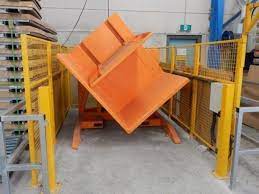
Eliminating the Root Cause of Injury
The number one cause of injury in this process is manual handling. The human body is not designed to be a crane. By introducing a pallet inverter, you are not just making the job easier; you are removing the hazard itself. The operator simply uses a forklift to place the entire pallet into the machine. From there, hydraulic controls take over. The clamping, rotating, and transfer are all done by the power of the machine. The worker's involvement is reduced to pushing buttons or pulling levers from a safe distance. I've spoken to countless warehouse managers who tell me their injury incident rates in the shipping department dropped significantly after they installed an inverter. It’s one of the most direct and effective ways to protect your team.
Creating a Controlled, Stable Process
An often-overlooked safety benefit is stability. When a team is manually unstacking a pallet, the load can become unstable. Boxes can shift, and the entire stack can lean or even topple over, creating a serious risk of crushing injuries. This is especially true with non-uniform products or poorly wrapped pallets. A pallet inverter addresses this by securing the entire load with powerful, adjustable clamping platforms before it ever moves. The load is held firmly in place throughout the 180-degree rotation. The entire process is smooth, controlled, and predictable. There is no risk of a sudden shift or collapse. This mechanical stability provides a level of safety that manual handling can never match.
Boosting Team Morale and Productivity
Safety and morale are directly linked. When employees know that a company is investing in tools to make their job safer, they feel valued. It shows that management is concerned about their well-being, not just productivity numbers. This can lead to higher job satisfaction, lower employee turnover, and a more positive work culture. Furthermore, by removing the most physically exhausting and time-consuming task from their plate, you free them up to focus on other important activities like quality control checks, inventory management, or preparing the next shipment. They are less fatigued, more focused, and ultimately more productive throughout their shift.
| Ergonomic Risk Factor | Manual Restacking | Using a Pallet Inverter |
|---|---|---|
| Heavy Lifting | Constant; worker lifts every item | Eliminated; done by the machine |
| Awkward Postures | High; frequent bending and twisting | Eliminated; operator stands upright |
| Repetitive Motions | High; hundreds of repetitions per pallet | Eliminated; task is done once by machine |
| Risk of Falling Objects | High; unstable stacks can collapse | Very low; load is securely clamped |
| Physical Fatigue | Very high; leads to errors and injury | Low; minimal physical effort required |
What are the different types of pallet inverters and which is right for a Canadian facility?
You have recognized the problem and see that a pallet inverter is the right solution. That's a great first step. But now you face another question: which type of inverter do you need? The market offers several different designs, each with its own strengths. Choosing the correct model is crucial. Investing in a machine that doesn't fit your workflow, space, or volume can lead to a new set of inefficiencies. The key is to match the machine's capabilities to your facility's specific needs.
The primary types of pallet inverters are the freestanding (or stationary) model, the mobile pallet inverter, and the fully automated inline system. For most Canadian facilities dealing with mixed US and EU shipments, the freestanding model loaded by a forklift offers the best combination of performance, cost-effectiveness, and flexibility. However, your specific volume, warehouse layout, and budget will determine the ideal choice.
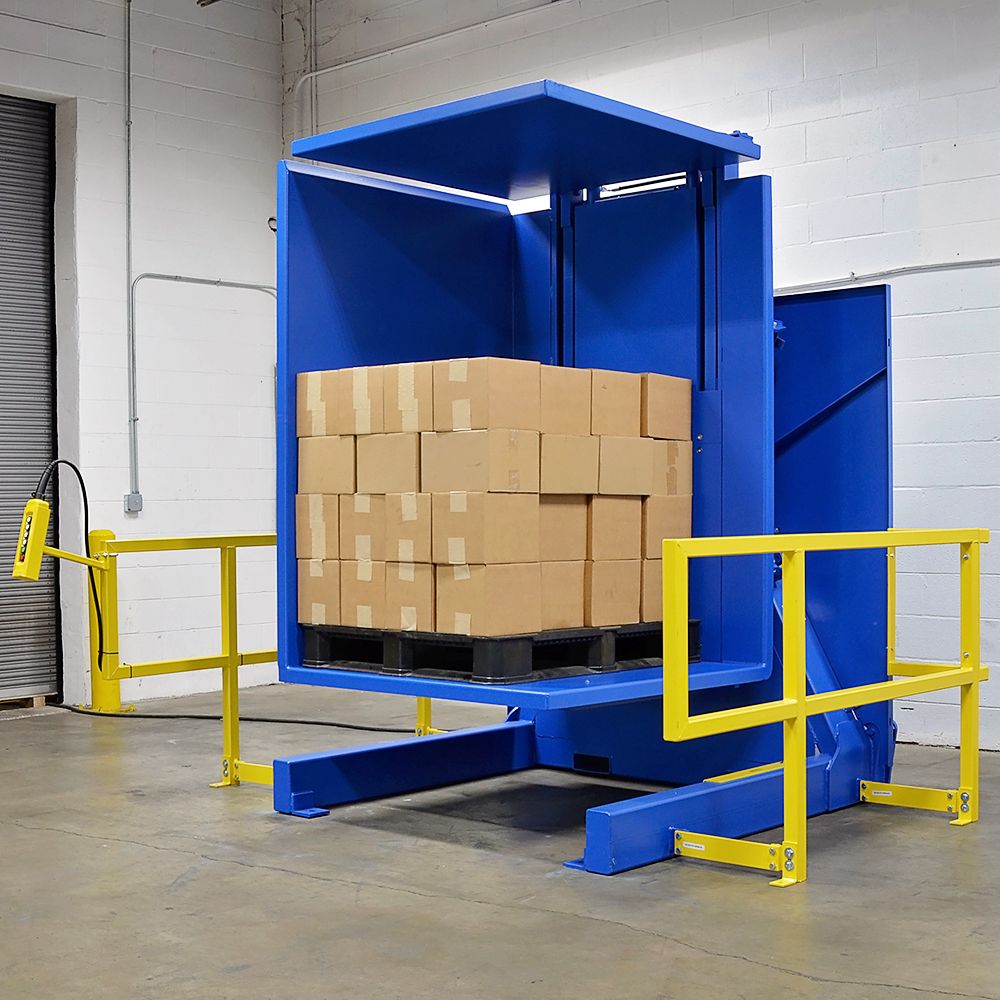
The Workhorse: Freestanding Pallet Inverters
This is the most common type of pallet inverter and the one I recommend for a majority of applications. As the name suggests, it's a stationary machine that is bolted to the floor, typically in the shipping or receiving area. An operator uses a standard forklift to load a pallet into the machine's opening. The machine then clamps, rotates, and allows for the pallet exchange. These models are robust, reliable, and highly efficient. They are perfect for facilities that have a dedicated area for this process and handle a consistent volume of pallets that need switching. Their main advantages are speed, durability, and a lower cost compared to fully automated systems. When considering a freestanding model, you need to account for the floor space it requires, including the maneuvering room for the forklift.
The Flexible Solution: Mobile Pallet Inverters
For very large warehouses or facilities without a single, dedicated processing area, a mobile pallet inverter can be an excellent choice. These units are self-contained, often battery-powered, and can be moved around the facility like a pallet jack. This means you can take the inverter to the pallet, rather than bringing the pallet to the inverter. This is incredibly useful for operations where pallet switching needs to happen in various locations, such as at the end of different production lines or in different warehouse aisles. While they offer unmatched flexibility, they are typically slower than freestanding models and may have lower weight capacities. They are a specialized solution for specific logistical challenges, not usually the primary choice for a high-volume shipping dock.
The Ultimate in Automation: Inline Pallet Changers
For high-volume distribution centers or manufacturing plants, an inline pallet changer is the top-tier solution. This type of machine is not a standalone unit but is integrated directly into an automated conveyor line. Pallets travel down the conveyor, enter the changer, are automatically switched, and then continue on their way without any forklift or operator intervention. This offers the highest possible throughput and eliminates all manual labor from the process. However, the investment is significantly higher, and the integration into an existing conveyor system requires careful planning and engineering. This solution is best for companies with very high and predictable volumes where the goal is complete "lights-out" automation.
| Pallet Inverter Type | Best For | Speed (Throughput) | Flexibility | Cost |
|---|---|---|---|---|
| Freestanding | Most warehouses; dedicated shipping/receiving areas | High (20-40 pallets/hour) | Moderate (fixed location) | Medium |
| Mobile | Large facilities with multiple work zones | Low (5-10 pallets/hour) | Very High (moveable) | Medium-High |
| Inline | High-volume automated conveyor systems | Very High (60+ pallets/hour) | Low (fixed in a line) | High |
From an Engineer's View: Why ROI is more than just a number?
Over the years, I've had countless conversations with smart, data-driven business owners and CEOs. People like Javier Morales, who scrutinize every investment and demand a clear Return on Investment (ROI). They want to see the numbers: labor savings, reduced damage costs, faster turnaround. And they are right to do so. A good investment must make financial sense. But after designing, building, and seeing these machines in action in hundreds of factories, I have come to believe that the true ROI of a machine like a pallet inverter goes far beyond a simple calculation.
From my perspective as an engineer and a factory founder, the real ROI of a pallet inverter is not just in the money it saves, but in the operational resilience it creates. It is a strategic investment in capability. It builds a stronger, more flexible, and more scalable logistics foundation that protects your business from disruption, elevates your reputation for quality, and unlocks growth opportunities you couldn't otherwise pursue.
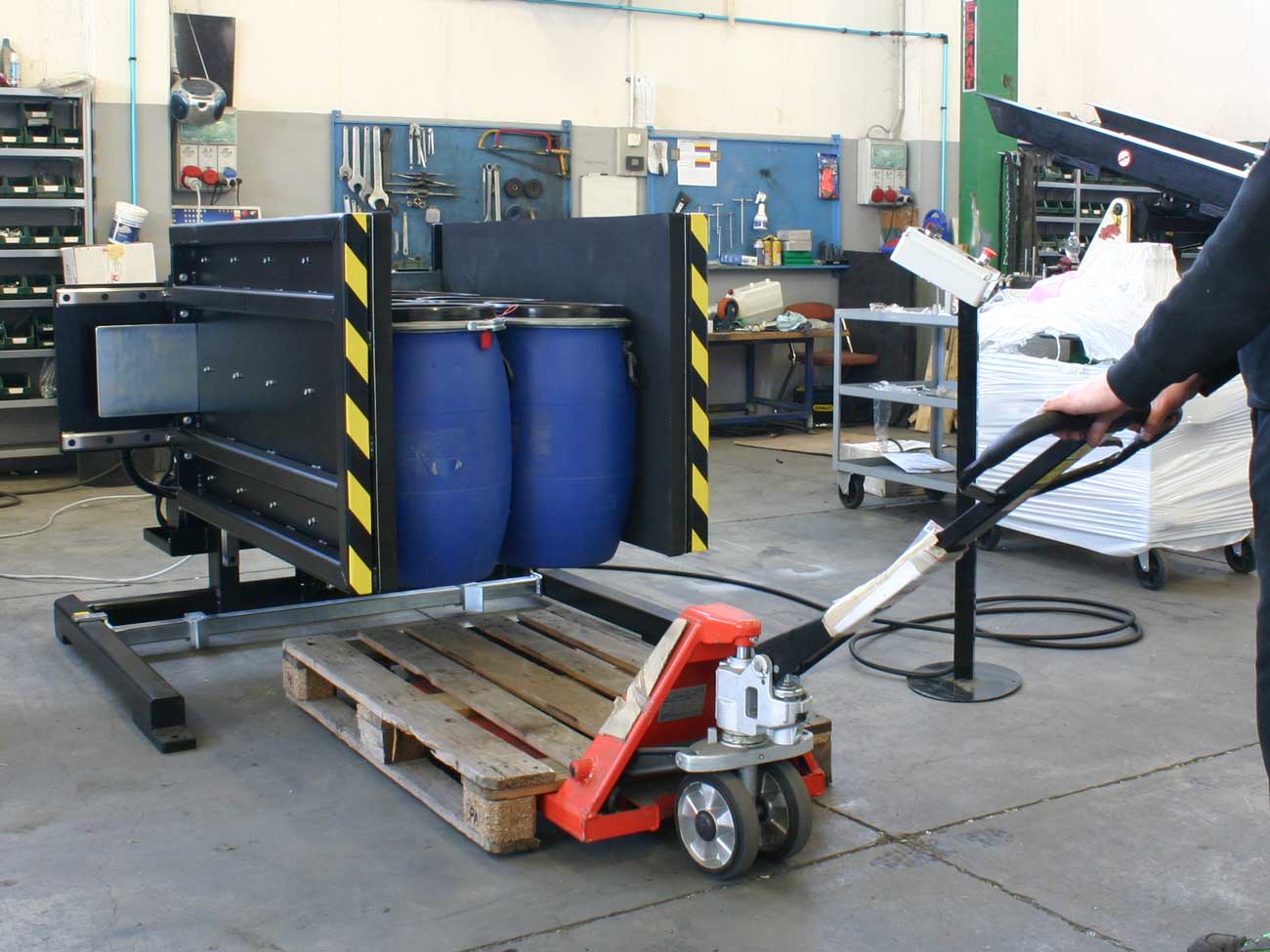
Beyond Labor Savings: The Value of Consistency
A machine performs its task the same way, every single time. A pallet inverter clamps with the same pressure, rotates at the same speed, and completes its cycle in the same amount of time. This consistency is invaluable. It removes variables from your process. You can plan your labor and shipping schedules with much greater accuracy. Your customers receive loads that are perfectly stable and stacked because the process was mechanized, not subject to human variation. This level of quality and predictability is a form of ROI that is hard to quantify but is incredibly valuable. It builds customer trust and reduces the "soft costs" associated with fixing inconsistencies. This directly contributes to a higher utilization of your plant's capacity, a key goal for any top-level manager.
Future-Proofing Your Operations
When you invest in a pallet inverter, you are buying more than a solution to today's problem. You are buying agility for tomorrow. What happens if a major new customer comes along, but they require a specific type of plastic slave pallet for their internal automated system? Without an inverter, that might be a deal-breaker. With an inverter, it's a simple process. What if a new international market opens up, but it has yet another unique pallet standard? You are already equipped to handle it. I see this as a strategic investment in flexibility. It ensures that your logistics capabilities will not be the bottleneck that prevents you from seizing new opportunities. It's about future-proofing your operation against market changes and customer demands.
A Tool for Growth, Not Just a Cost Center
I remember a client in the food ingredients business. He hesitated for months over the cost of an inverter. He ran the numbers on labor savings, and it looked okay, but not spectacular. He finally made the investment, primarily for safety reasons. About a year later, he called me. He had just won the biggest contract in his company's history with a major European supermarket chain. He told me, "Vincent, I never could have even bid on that contract before. We couldn't have handled the volume or met their pallet requirements. That one deal paid for the machine three times over." That story has always stuck with me. He initially saw the machine as a cost-saving device. He later realized it was a growth-enabling tool. That is the true ROI. It’s not just about reducing costs; it's about what the investment allows you to become.
Conclusion
Pallet inverters are a key strategic tool for Canadian businesses, streamlining US/EU trade, boosting safety, and enhancing overall operational efficiency.




